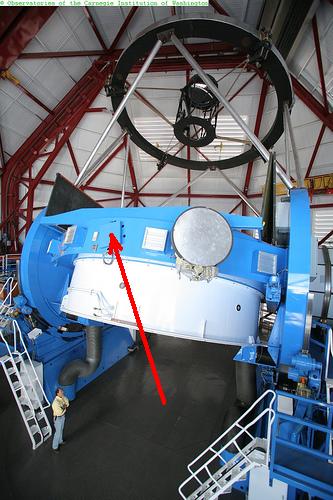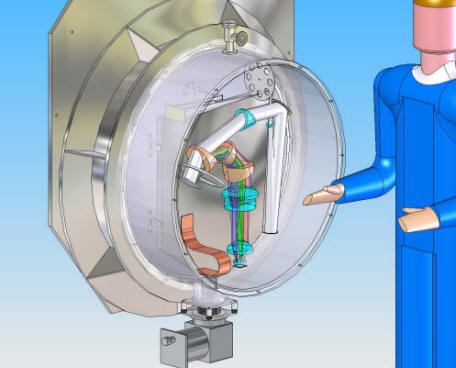FIRE
A Folded-port InfraRed Echellette for the Magellan Telescopes
Conceptual rendering of the FIRE dewar, with opto-mechanical components removed to show light path. Telescope beam enters from left, behind the cylindrical vacuum vessel. Lego-shaped man shown for scale.
FIRE will mount at one of Magellan's bent-Gregorian folded ports, whose location is indicated with arrow. (Photo courtesy A. Uomoto, OCIW)
| Optical layout of FIRE, showing 1:1 pre-slit Offner relay, reflecting collimator, cross-dispersing prism array, reflective diffraction grating, and four-element camera. (R. Bernstein) |
Simulated spectral format for FIRE, showing coverage from l ~ 0.85-2.51 microns per exposure. Bounding square shows the footprint of the 2K x 2K HAWAII-2RG detector. Slit length is 7 arcseconds. Only 1 free spectral range is shown for each order; on an actual spectrum more light will be recovered at the order boundaries.
Spectral Format
The bottom figure shows the footprint of an observed object on FIRE's detector. In this figure, the prisms have dispersed light in the vertical direction, and the diffraction grating has dispersed the light at high resolution in the horizontal direction. The prisms have the effect of sorting the different spectral orders from the diffraction grating, in order of central wavelength down the detector.
Each exposure in echellette mode covers the full z-K bands in a single setup - a unique attribute among spectrographs with comparable resolution.
Optical Layout
The spectrograph's optical layout is shown in the schematic below. The telescope focal plane is located at left-center in the figure. A 1:1, on-axis, cold Offner relay re-images the telescope focal plane onto the spectrograph slit, while providing a sharp pupil and Lyot stop to baffle thermal emission from the telescope support structure. Off-axis light reflected from the back of the slit will be directed into a small infrared acquisition camera, which is used for object finding and telescope guiding.
After passing through the slit, the telescope's f/11 beam is collimated using a tilted field lens and on-axis spherical mirror. The beam is then directed through a network of ZnSe and Infrasil (IR-grade fused silica) prisms which are used for cross dispersion. One of the prisms is used in double-pass, all others are single pass but their apex angles and tilts have been tuned to moderate anamorphic magnification of the beam. Primary dispersion is achieved with an R1 echelle grating operated in quasi-Littrow mode.
The camera is a four element design incorporating two aspheric surfaces. It produces excellent images (>90%EE within one pixel) over the entire detector focal plane. With 0.18 arcsecond pixels, FIRE's optics will sample the excellent seeing conditions often present at Magellan.

Deployment
FIRE's lightweight design allows it to be mounted on one of Magellan's folded ports. These instrument ports are located around the perimeter of the telescope primary, at bent-Gregorian focus (see photograph). The folded ports are addressed by rotation of the telescope tertiary mirror (not visible in photo). This operation takes only 10-15 minutes, and can be accomplished during the night.
Current plans call for FIRE to be mounted on the telescope on a long-term basis. It will therefore be available for observing Gamma-ray bursts or other targets of opportunity during all phases of the lunar cycle.

Overview
FIRE is a dual-mode infrared (IR) spectrometer designed for operation at the Magellan telescopes at Las Campanas Observatory, Chile. Its primary mode employs a combination of a diffraction grating and four prisms to deliver cross-dispersed spectra covering the whole near-IR bandpass in a single exposure, with wavelength resolution of R = Dl / l = 6000. FIRE also offers a low dispersion mode, where the diffraction grating is replaced by a mirror to yield R~1200 spectra dispersed solely by prisms.
The design incorporates a large-format, 2K x 2K pixel IR focal plane array. The optics and detector will be enclosed together in a 77K vacuum cryogenic dewar, which will be cooled by a closed cycle helium refrigerator. FIRE's design has been kept compact, and it is geared toward minimal mechanical and thermal engineering complexity.
The Magellan Telescopes at Las Campanas Observatory, Chile.